ALBRO LAKE
INTRODUCTION
 Established near Dartmouth, Nova Scotia in 1942, Naval Radio Station (NRS)
Albro Lake call sign CFH, served as a naval radio communications
station for the Atlantic Coast. The station was divided into a receiving
site at Albro Lake and a transmitter site at Newport Corner, Nova Scotia.
Set up under a veil of secrecy during the height of the North Atlantic
U-boat threat, this small village near Halifax became the home of an invaluable
weapon during the Battle of the Atlantic. Despite a price tag of more than
$6 million, an exorbitant expense in those days, the facility more than
paid for itself in Allied shipping saved. Its signal could be heard and
read from Murmansk to the Falklands and half way around the world. Renamed
HMC NRS Albro Lake on July 1, 1956, the station served under that name
until her closure.
Established near Dartmouth, Nova Scotia in 1942, Naval Radio Station (NRS)
Albro Lake call sign CFH, served as a naval radio communications
station for the Atlantic Coast. The station was divided into a receiving
site at Albro Lake and a transmitter site at Newport Corner, Nova Scotia.
Set up under a veil of secrecy during the height of the North Atlantic
U-boat threat, this small village near Halifax became the home of an invaluable
weapon during the Battle of the Atlantic. Despite a price tag of more than
$6 million, an exorbitant expense in those days, the facility more than
paid for itself in Allied shipping saved. Its signal could be heard and
read from Murmansk to the Falklands and half way around the world. Renamed
HMC NRS Albro Lake on July 1, 1956, the station served under that name
until her closure.
The growth of Dartmouth from a small town into a city created problems
for receiving radio signals at Albro Lake. The Navy decided to relocate
the radio station and as a result, Albro Lake closed in 1968. A new radio
communications station, Canadian Forces Station Mill Cove, was opened 40
miles southwest of Halifax. The cutover occurred from August 31 to September
18, 1967. |
HISTORY
During World War I, naval radio had its beginnings in the Halifax area
with station VAA, the first of its kind. As best as anyone knows, VAA was
a very small station located in a shed at HMC Dockyard and was used mainly
to communicate with naval vessels or all ships within the harbour area.
It has been confirmed that VAA transmitted weather broadcasts [1].
Between World War I and World War II, the navy simply used the regular
Department of Marine and Fisheries coastal stations to communicate with
their ships. When war broke out in 1939, the RCN took over the most powerful
station in the maritimes which was the Marconi station located at Glace
Bay, Nova Scotia. Soon the station found itself rather overloaded with
traffic caused by the addition of HMC ships. Glace Bay, call sign VAS,
was the most powerful station in eastern Canada at the time and so it continued
to serve the Navy throughout the war.
 |
| Glace Bay, call sign VAS, was situated on Cape Breton Island, Nova
Scotia. (Map courtesy Multimap.com) |
With ever expanding naval activities, steps had to be taken to improve
communications and address the every increasing volumes of traffic. To
meet the challenge, the Royal Canadian Navy would expand operations
by building it's own station at Albro Lake in Halifax. It was to be four
times as powerful as the Glace Bay Station and designed to control the
North Atlantic convoy routes. Not only was it to be more powerful, it was
the first Canadian coastal station to use the high frequency portion of
the radio spectrum. Albro Lake would communicate with all ships, both naval
and merchant, therefore both naval and civilian operators had to be on
staff along with, one Department of Transport operator on each shift and
naval radio telegraph operators. The first person sent there to manage
the Department Of Transport staff was Charles Williams. Charlie, at the
time of this promotion, was senior operator at Camperdown Radio VCS.
The call sign of this new station at Albro Lake was CFH which was passed
on from a station opened a few years prior to World War II in the brick
building at the foot of North Street in the city of Halifax near the centre
gate of HMCS STADACONA. During the war, CFH continually coded its call
sign. In a departure from past practice, the new station did not monitor
500 kilohertz International calling frequency so any vessel wanting to
communicate with CFH had to use one of the high frequency bands.
Glace Bay was manned by civilian employees at all times and it's main
job after Albro Lake went in service was to broadcast the BAMS (British
Admiralty Merchant Service) traffic. This was a broadcast for the multitude
of merchant ships that were in convoy back and forth across the Atlantic.
Fred Ware, a telegraphist during WWII has these recollections: "During
the early stages of construction in the summer of 1941, the Halifax naval
authorities asked for volunteers to go to Albro Lake to help fight the
forest fires that were threatening the construction area. When we had our
1978 reunion in Halifax-Dartmouth, I was sure surprised to see the station
in the middle of the city.
 |
| Shown here is the Albro Lake area of Dartmouth, N.S. from a current
map (2003). The red dot denotes the location of the CFH Operations Building
from 1943 to 1967. Lancaster Drive was the lane to the operations building
and it ended right where it touches Golden Acres Park. The construction
of subdivisions and surrounding streets started after the navy moved CFH
from Albro Lake to Mill Cove in 1967. (Map courtesy MapArt) |
POSTWAR NAMING FOR NAVAL RADIO STATIONS
As David Freeman describes in Canadian Warship Names (pages 174-177,
and 304) the following was the post war naming policy for Naval Radio Stations.
"A tender was originally a small vessel employed to attend
to a larger vessel for duties such as ferrying personnel and stores, or
for training. She was under the direct command of her parent ship but was
not to be confused with the ship's boats—she was too big to hoist in. In
later days, shore establishments had small craft attached to them as tenders.
Further, some administrative units ashore were referred to as tenders".
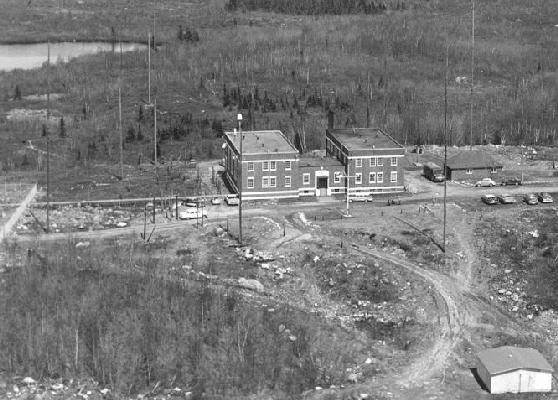 |
| A closeup view of the station the way it appeared in the early 1950's.
(Photo
by (N) F.O.A.C submitted by R.M. Canning) |
 |
| Another view of Albro Lake. (DND photo
01_1180x9240) |
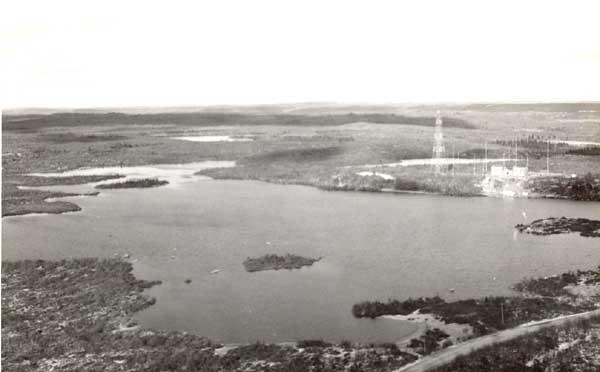 |
| This early 1950's aerial view shows the station's location relative
to the surrounding countryside. (Photo by (N) F.O.A.C submitted by
R.M. Canning) |
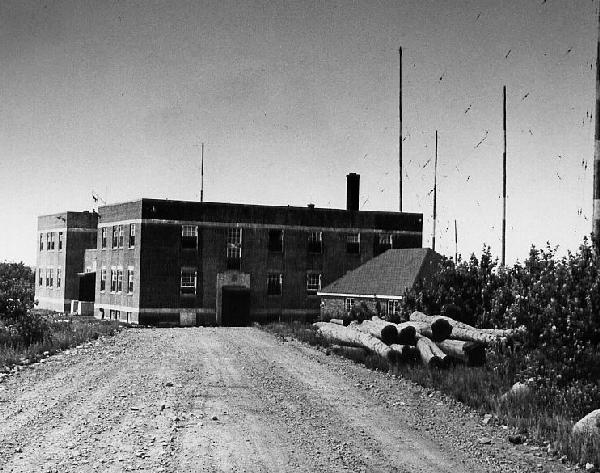 |
| CFH Albro Lake, taken in 1947. The building was H shaped. In reference
to the front door, the dormitory was upstairs, the galley at the back,
radio operations were to the left and the officer's office was to
the right. The centre of spare-time activity during the colder months was
the large recreation room in the basement of the station, where movies
and dances were regular features. (Photo by Bob Palmer. Submitted by
Spud Roscoe) |
"Basically, up to 1949, Naval Radio Stations (NRS) were tenders
to parent establishments. In the beginning, some of the NRS were relatively
small affairs. In December 1947, for example Coverdale, Aldergrove and
Albro Lake were commanded by officers; a chief petty officer was in charge
in Gloucester; and Montreal Circle in Prince Rupert had an operator-in-charge.
As the size of a NRS grew, so too did the administrative problems caused
by being a tender. Eventually Naval Service Head Quarters, Ottawa (NSHQ)
realized that commissioning naval radio stations was the best solution
to problem. With the commissioning of NRS, the cap tally HMC RADIO
STATION came into being. Ratings in ALDERGROVE, CHURCHILL, COVERDALE,
GLOUCESTER and INUVIK all eventually wore their respective cap tally. Ratings
in all other NRS wore the cap tally HMC RADIO STATION."
"By 1955, COVERDALE, GLOUCESTER and ALDERGROVE were in commission as
Fleet Establishments while the rest of the NRS were tenders. Albro Lake
and Newport Corners were tenders to STADACONA while the rest were tenders
to GLOUCESTER. It was at this time that the Director Naval Communications
(DN Com) requested that the commissioned NRS be upgraded to
HMCS and the tenders be named "HMC NRS". There is no record of a
reply and early in 1956, DN Com repeated his request. This led to naval
board approval and on July 1 1956, all NRS were redesignated in accordance
with the wishes of DN Com".
"NRS took their names for the geographical location in which
they were located. Generally, these were the names of the closest communities
but in the case of ALDERGROVE, there was a suggestion to have her named
Vancouver, In the case of GLOUCESTER, there was no local community so she
took the name of the township. Taking their names from the local community
had a WWII precedent in that the signal school in St. Hyacinthe was called
after the town in which it was located"
"The last NRS was to be named Blandford. This was the replacement for
ALBRO LAKE. Under construction when unification occurred, Blandford's name
was changed and she was put in service as CFS Mill Cove. A rather
striking badge had already been designed for Blandford whose name came
from the peninsula since there was no community nearby. Unification of
the armed forces had other ramifications on NRS"
In 1948, HMCS Gloucester was established as the school for Communicator
Supplementary and later Radiomen Special training. As
the trade names changed, Gloucester also became the training center for
all
Radio Supplemental types in 1962. This trade along with
operator specialties in the RCSIGS and RCAF later evolved into the "Communicator
Research, 291" trade. Between 1965 and 1968 all naval radio stations became
CFS. (Canadian Forces Station).
THE EXPLOSION OF 1945
The Halifax explosion of July 18, 1945 put Albro Lake off the air but
only temporarily. Spud Roscoe of Halifax relates the following story about
his friend George who was on duty when it happened.
"Trained Operator Telegraphist George D. Crowell, from Liverpool, Nova
Scotia, was working the Atlantic Broadcast at the Albro Lake radio station
on the evening shift of July 18th, 1945. Around 18:30 local time there,
was a lull in this broadcast and George got up to walk around and chat
with any of those on duty who were not busy.
The war in Europe had terminated about eight weeks previous to this
and nearly all RCN ships were ordered to the Bedford Basin Naval Powder
Ammunition Depot to discharge their ammunition as fast as possible. Some
of the ships were to be refitted for the war in the Pacific while the rest
were to be laid up. There was political pressure to get these ships unloaded
and their crews back home as soon as possible. For this reason, many of
the rules and regulations were ignored. As a result, this magazine was
literally overloaded with explosives of every kind imaginable. They
were piled anywhere and everywhere within the magazine compound.
The ammunition depot was less than three miles west of the Albro Lake
station and the station itself was situated on a hill. When George got
up, he looked out the window towards the magazine and immediately saw the
mushroom cloud from the explosion. What timing! Immediately he yelled
"EXPLOSION" and instructed everyone to hit the deck. George dove in under
a desk with Janie the dog, the station's mascot. One of the staff, believed
to be Quigley, had been on the Murmansk run to Russia, and brought this
dog back. They claimed she was a Russian wolfhound but George said she
looked like a Staffordshire terrier.
Those in the immediate vicinity of George heeded his warning. When the
blast struck the station, it blew in all the windows and also severed the
control lines from Albro Lake to the Newport Corner transmitter site. These
lines ran past the magazine. Albro Lake had been left with receiving but
no transmitting capability.
Below, in the photograph of the Operations Room, one can see a
Canadian Marconi CM11 transmitter in the upper left corner and it's believed
that this is the same one that was installed in 1945. This radio was designated
to communicate with the Newport Corner transmitter site in case of emergency.
Lieutenant Dill was in command of the Albro Lake station and was on premises
when this explosion took place. He ordered George to contact Newport Corner
using this CM11.
George kept calling and calling, but did not make contact with Newport
Corner. It was the perception that the duty watch at Newport Corner was
not paying attention. They did not hear George call nor did they notice
that no one was keying the transmitters.
The rest of the Albro staff were to head to the dormitory on the upper
floor of the Operations building, collect their personal effects and prepare
to abandon the station. It was late in the evening and quite dark when
they boarded an army truck. This truck took them to an army camp past the
RCAF station at Eastern Passage. They spent the night in an army hut with
no bunks or cots and had to sleep on the floor. Later I asked George what
became of Janie the dog and he couldn't remember. He suspects someone located
her and took her to the camp. After the explosion, most dogs in this area
became very nervous whenever hearing thunder-like sounds.
The precise reason for the explosion has never been officially determined.
It is believed that a fire, intentionally started on a barge as personnel
prepared their evening meal, ignited the grass and brush around the jetty
and spread to the wharf where earlier in the afternoon, a corvette had
put all of her ammunition ashore.
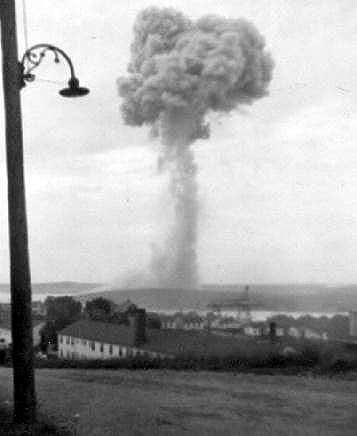 |
| Several minutes after the initial explosion, a mushroom cloud forms.
(Photo by Hugh LaFleur) |
After the explosion, there was an exodus of the population from Halifax,
Dartmouth and all around Halifax Harbour and Bedford Basin. Nearly everyone
wanted to get as far from this explosion as possible because there were
a series a smaller explosions which occurred after the main blast. Most
of the population left their doors and windows wide open to prevent further
damage from the secondary blasts. For those who opted to stay behind, they
left their broadcast radios on full volume. Radio broadcasting normally
shut down at night but the local stations were kept on the air all night
with their announcers providing the latest bulletins. To their credit,
they kept the population informed and did everything possible to prevent
further panic.
The magazine continued rumbling from one small explosion after another
all night and put on a magnificent display of fire works. Much of the exploding
ammunition was tracer bullets, the ones that leave a visual streak. The
last large explosion was heard at 03:55 on the morning of July 19th. The
police and army continually patrolled the area to assist with the evacuation
and to prevent looting. Dartmouth was closed and evacuated west of Ochterloney
Street. This included the Albro Lake station that was two miles west of
this street in the direction of the magazine. The north end of Halifax
was closed and evacuated.
 |
| This was the night scene of the explosion. Secondary blasts continued
on throughout the night. (Photo by J. Hayward, Halifax) |
 |
| 18 July,1945 - The building above was moderately
damaged. (RCN photo) |
 |
| 18 July,1945 - Unexploded shells are in
evidence. (RCN photo) |
| Photos via Bob Palmer |
On July 19th, George and several members of the Albro Lake staff were
taken to the RCAF Station Gorsebrook on South Street on the south
side of Halifax. The air force loaned them a couple of transmitters.
Jointly, they managed to set up a temporary radio station for a few days
until the control lines could be repaired, the windows replaced and the
building at Albro Lake made ready for their return.
The naval damage control party and many volunteers risked their own
lives at the magazine and managed to prevent the whole magazine from exploding.
If this had taken place the officials were convinced it would have destroyed
all of Halifax, Dartmouth, Bedford and everything else within the area.
There were a number of injuries but it's hard to believe that only one
life was lost. He was a member of the navy that had run down to the fire
on the barge when it first started.
By the evening of July 19th, twenty four hours after the initial explosion,
the authorities felt that any future explosions would be minor and gave
permission for everyone to return to their homes if they had one to return
to. The last of the fires at the magazine were extinguished by July 20th.
Many homes and places of business in Halifax, Dartmouth and around the
area were badly damaged. The government compensated those with damage for
their loss and for sometime, any new car in the area was labeled an explosion
car.
The 1945 explosion was also reminiscent of the even more powerful one
which shook Halifax on Dec 6th 1917 and killed at least 1,600 people. On
that day, two ships collided in Halifax Harbour. One was loaded with
munitions for the war in Europe. The explosion that resulted from this
collision destroyed most of the city of Halifax. The blast was the world's
largest man made explosion up until the atomic bomb was dropped on Hiroshima,
Japan, in 1945. All explosions were compared in size to the 1917 Halifax
explosion for many years thereafter. The preceding fire on these ships
had attracted a lot of attention and many were watching the smoke through
the windows of their residences. As a result, the explosion shattered
these windows blinding those standing behind them. At further distances
from ground zero, many were maimed or scarred from the explosion. By 1945,
there had also been a couple of incidents where ships loaded with
munitions caught fire, and were intentionally sunk in Halifax Harbour to
prevent an explosion."
OPERATIONS AT CFH
Trained Operator Telegraphist, George D. Crowell still remembers aspects
of WWII operations.
"During WWII, ships wishing to enter the gates at Halifax Harbour,
could obtain permission by contacting CFH on 425 kcs (CW) or 1740
kcs ( AM). The only console in the Operations Room that did not use the
National RAS receiver (a modified HROjr) was the high speed CW circuit
to Whitehall, England. Here diversity reception was used. Three Marconi
receivers, under common AVC control pulled in the signal using three terminated
rhombic antennas pointed to England. To adjust for propagation conditions,
the receive frequency was changed twice daily, once at night and again
in the morning".
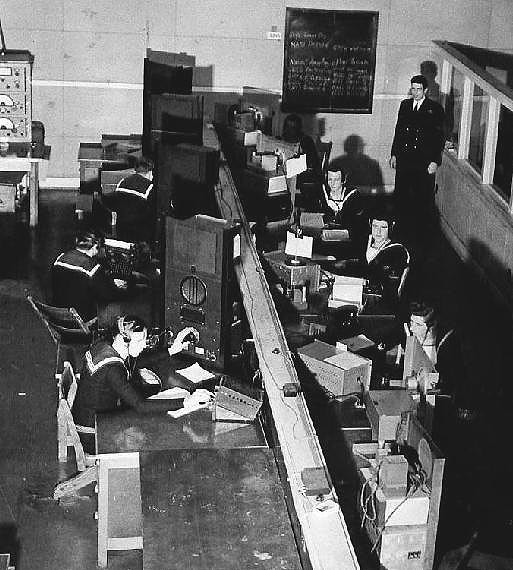 |
| The operations room Halifax Radio CFH in 1947. Clockwise: Jim McGowan,
Shorty Palmerton, Bob Walker, Norm Jermy, Scotty McLaughlan, Chuck Sabean
and Ron Dennis. Standing: Petty Officer Jack Carson. A Canadian Marconi
CM11 transmitter can be seen in the upper left corner. The operator
nearest bottom left of the photo is adjusting a panoramic display. (Photo
by Bob Palmer. Submitted by Spud Roscoe)
This picture was taken during day shift, when the radio ops had
to don No 3s ... which approximated a full uniform but no lanyard. Evening
and graveyard shifts allowed the real working dress – jeans. They were
so much more comfortable!
Personnel were issued two 2 full uniforms (possibly three) and two sets
of working dungarees ... two jean trousers, two jean shirts and one jean
jacket. |
As reported in May 1950 Crowsnest Magazine, the station had 55 staff
members. All but six were communications personnel. The others consisted
of three radio technicians, two cooks and one storesman.
Rounding out the complement were four civilian operators of the Department
of Transport (Radio Division).
They assisted by handling the large amount of commercial traffic going
through the station, keeping records,
assessing tolls, and so forth. This traffic included telegrams signalled
from ships and distant countries. In this time frame the station was clearing
an average of about 12,000 messages per month.
Dennis Stapleton served as an operator at Albro Lake. He provides this
comment regarding Morse monitoring while sending. "When I first was drafted
to Albro Lake in the mid 50s, we had to work ships without hearing ourselves
send. Later on, the Hammarlund SP-600 receivers were modified to
monitor Morse code. This must have improved the readability of the signals
transmitted to shipborne operators tremendously. Most of us felt we were
sending excellent Morse, but when we could actually hear what we were sending,
we had a reality check. For me, the big correction was to adjust
the height of the key contact for a larger gap. The larger gap slowed
down the sending a bit but made for a more defined and readable fist".
In the 1956 time frame, the watch schedule was arranged like this.
About 20 single men lived in quarters on the base, and another 60 in
married quarters, or ashore on subsistence allowance. The radio watches
were continuous, around the clock and consisted of:
2 days of day watches from 8:00 a.m. to 4:00 p.m.
2 days of evening watches from 4:00 p.m. to 12:00 p.m.
2 days of middles watches from 12:00 p.m. to 8:00 a.m.
You then received 48 hours off, before repeating the cycle all over
again.
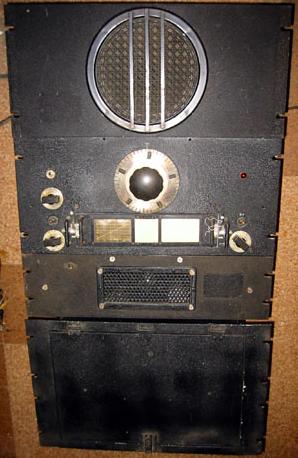 |
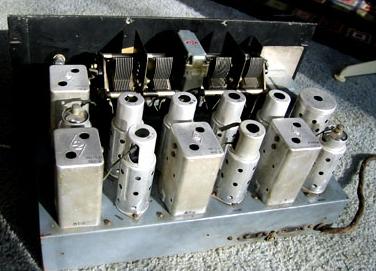 |
In the Operations room photo, the operator in the lower left corner
is using the National RAS receiver which covered from 190 kc to 30 Mc but
it may not have gone by that name in RCN service . Originally built for
the U.S. Navy between 1939 to the end of WWII , it was a cousin to
National's HRO Jr receiver. The RAS did not have the S-meter, crystal filter
or band spread features of the HRO. It's IF was also shifted to 175 Kc
which allowed it to provide complete coverage of the maritime frequencies
between 190 Kc and 550 Kc. For the operator's convenience, the power
supply front panel has a center window to view the rectifier tube glow.
The assembly consisted of the following components and could be mounted
in any sequence:
HRO jr receiver 8.75" (CNA 46080)
Power supply 5.25"
Coil storage container 12"
Speaker cabinet 8.75"
Weighing 90 lbs, it was quite heavy for a receiver in the vacuum tube
era. At the right is a photo of the chassis.
[Photos via E-bay] |
In 1964, an entry in the Naval General Orders (NGO's) authorized Albro
Lake to hold 40 telegraphic typewriters.
Click on any photo to enlarge.
|
|
 |
This message was sent on May 9, 1945 from
U-858, the first U-boat to surrender on the Western side of the Atlantic.
Operator George Crowell received the message but other operators copied
along on their own receivers in order to get their name on the message.
U-858 surrendered to the Americans and was the first German warship to
do so. She was ordered to proceed to Fort Miles, Delaware where she arrived
on May 14, 1945. (Courtesy George Crowell) |
 |
A station-to-lake view. (Photo by (N) F.O.A.C
submitted by R.M. Canning) |
 |
A lake-to-station view. (Photo by (N) F.O.A.C
submitted by R.M. Canning) |
 |
Ship-to-shore double bank bays circa 1950. CW
was sent and received from these positions. Compare this to the 1947 photo
above. (Photo by (N) F.O.A.C submitted by R.M. Canning)
D.M. Stapleton, a former operator at Albro Lake comments. "The
bays, from bottom to top: 6 (empty), 8, 12, 16 and 24 mcs. Note the empty
bays on the opposite side of the operating consoles. When traffic got really
busy, another op would take up position to help out - "double banking"
as it was known. When one or the other was working a vessel on the answering
frequency (fixed) he would hold up his arm to indicate he was working a
vessel on this frequency before getting the ship operator to shift to a
working frequency. When he brought down his arm, his opposite number
then would reply to his caller. In the mid 50's, technicians built audio
oscillators so the operators could hear themselves sending". |
 |
LSRM Dave Steward updates the stateboard in 1961.
(Photo by (N) F.O.A.C submitted by R.M. Canning) |
 |
Teletype room circa 1950. The console in the foreground and the one
behind it is fitted with a Model 15 Teletype, paper tape punch and Model
14 T-D (tape reader). Third from foreground is a Model 19. (Photo by
(N) F.O.A.C submitted by R.M. Canning) |
 |
Control panel for the telephone control lines
from Albro Lake to Newport Corners in 1945. (Photo submitted by Spud
Roscoe) |
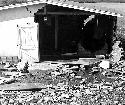 |
Power house explosion, May 1951. (Photo by
(N) F.O.A.C submitted by R.M. Canning) |
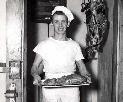 |
P2CK J.Goodman in main refrigerator circa 1950.
(Photo
by (N) F.O.A.C submitted by R.M. Canning) |
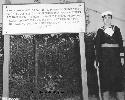 |
A.B. Roberts standing guard duty. (Photo by
(N) F.O.A.C submitted by R.M. Canning) |
 |
Albro Lake basketball team. Any ID's would be
appreciated. The station made quite a name for itself in the realm of sports.
In spite of the station's comparatively small complement, its softball,
hockey and basketball teams established excellent records in the Halifax
and Dartmouth leagues. (Photo by (N) F.O.A.C submitted by R.M.
Canning) |
 |
Albro Lake Hockey Team. (year unknown)
Front row (L-R): C2RM Joe Morrow, others unidentified.
Back row (L-R): First 4 unidentified, C1RM Renee Duschene. (Photo
by (N) F.O.A.C submitted by R.M. Canning) |
 |
Albro Lake Hockey Team - 1960 Interpart
Champions. (Photo submitted by Ronald Yaschuk e-mail: ronlynn(at)rogers.com) |
Dennis Stapleton was stationed at Albro Lake. He remembers the modifications
done to Hammarlund SP600 receivers. "When I worked ship-shore traffic in
the 12 Mhz band in 1956, the receiver of choice was the Hammarlund SP-600.
These were standard for all Naval comms until superseded by the RACAL RA-17s
in the early 1960s. Because of the lousy Morse keying by the Albro
ship-shore ops when working ships at sea, the techs made up local (monitor)
oscillators for the Hammarlunds so we could hear ourselves sending.
We were somewhat shocked, as we all believed each of us had a better fist
than the next guy and delivered smooth Morse".
COMMANDING OFFICERS
Jack Arrowsmith, provides some information about the former Commanding
Officers. Albro Lake was
tender to her parent establishment of Stadacona,
CFB Halifax. The following OIC's served at Albro Lake:
27.12.45 OIC/Albro Lake Radio Stn, Wt/Com Charles Walter FLEMING
RCN.
01.02.47 OIC/Albro Lake W/T Stn, Wt/Com Thomas James BAILEY RCN.
18.12.47 OIC/Albro Lake W/T Stn, Wt/Com Charles Walter FLEMING
RCN.
07.10.49 OIC/NRS Albro Lake, Lt(C) William Francis POTTER RCN.
09.02.51 OIC/NRS Albro Lake, Lt(C) George Albert HOYTE RCN.
01.08.52 OIC/NRS Albro Lake, Lt(C) Robert "Bob" Michael DUNAR
CD, RCN.
04.09.54 OIC NRS Albro Lake, Lt Francis Mirtle SKINNER RCN.
17.09.57 OIC/NRS Albro Lake, LCdr(C) William Charlew WHEELER
CD, RCN.
LCdr WHEELER was still the OIC in January 1960. If anyone can help to
complete this list, it would be appreciated.
|
HMC NAVAL RADIO STATION ALBRO LAKE - HERALDRY
BLAZON: Barry wavy of twelve, Argent and Azure , a flag Argent, bordered
Azure, on which two ship's masts in saltire proper pennants fling inwards
Argent and in the centre over all a torteau from which four lighting flashes
pointing outwards, two in vertical position and two horizontal, Gules.
SIGNIFICANCE: This station takes its name from the lakes near which
it is located on the northern edge of Dartmouth, N.S. Albro's Big Lake
and Albro's Little Lakes are quite small and were named after one of Halifax's
early settlers -- John Albro. Members of the Albro family were prominent
as merchants, ship's chandlers, iron mongers, tanners, office holders,
Justices of the Peace, members of Legislature , etc. The archivist of Halifax,
Dr. D.C. Harvey, discovered that Albro and Company hoisted a merchant's
private signal flag when entering Halifax Harbour. It is described as having
been a white flag with blue border.
In the badge design, the Albro flag of white with a blue border is charged
with two ship's masts in reference to the Chandlery business they
carried on. The disc and lightning flashes in red are intended to suggest
"Radio" or the transmission of messages by that means. The wavy field refers
to association with the sea viz the Navy.
Ship's Colours: Blue and White
According to David Freeman, the ALBRO LAKE badge only dates from 1956,
the year the naval radio station commissioned as a named ship. Pior to
1956, personnel at the base wore the cap tally "HMCS. Stadacona"
instead of "HMC Radio Station" as was the practice at other stations not
yet in commission. |
FOOTNOTES:
[1] Oral history via Mr. Reay Bridger or Mr. C. R. "Sprack" Spracklin
REFERENCES and CREDITS:
1) Canadian Warship Names. Lt. Cdr David J. Freeman CF
(Ret'd) .Vanwell Publishing. St. Catherines, Ont. 2000. ISBN 1-55125-048-9.
Selected quotes used with permission of the author.
2) Albro Lake badge graphic courtesy Pat Barnhouse; badge
copy courtesy Neil Goodwill <nmgoodwill(at)sympatico.ca.>
3) Spud Roscoe <spudroscoe(at)eastlink.ca>
4) R.M. Canning <Canning.M(at)forces.gc.ca
5) Jack Arrowsmith - deceased.
6) George D. Crowell
7) Hugh LaFleur)
8) J. Hayward, Halifax
9) Bob Palmer
10) Ronald Yaschuk < ronlynn(at)rogers.com>
11) May 1950 Crowsnest Magazine
12) Dennis Stapleton <lor-den(at)cogeco.ca>
13) Ronald Mark <rondmark@shaw.ca>
14) Bob Palmer <bob.palmer(at)rogers.com>
Back to Table of Contents
Apr 4/19
 Established near Dartmouth, Nova Scotia in 1942, Naval Radio Station (NRS)
Albro Lake call sign CFH, served as a naval radio communications
station for the Atlantic Coast. The station was divided into a receiving
site at Albro Lake and a transmitter site at Newport Corner, Nova Scotia.
Set up under a veil of secrecy during the height of the North Atlantic
U-boat threat, this small village near Halifax became the home of an invaluable
weapon during the Battle of the Atlantic. Despite a price tag of more than
$6 million, an exorbitant expense in those days, the facility more than
paid for itself in Allied shipping saved. Its signal could be heard and
read from Murmansk to the Falklands and half way around the world. Renamed
HMC NRS Albro Lake on July 1, 1956, the station served under that name
until her closure.
Established near Dartmouth, Nova Scotia in 1942, Naval Radio Station (NRS)
Albro Lake call sign CFH, served as a naval radio communications
station for the Atlantic Coast. The station was divided into a receiving
site at Albro Lake and a transmitter site at Newport Corner, Nova Scotia.
Set up under a veil of secrecy during the height of the North Atlantic
U-boat threat, this small village near Halifax became the home of an invaluable
weapon during the Battle of the Atlantic. Despite a price tag of more than
$6 million, an exorbitant expense in those days, the facility more than
paid for itself in Allied shipping saved. Its signal could be heard and
read from Murmansk to the Falklands and half way around the world. Renamed
HMC NRS Albro Lake on July 1, 1956, the station served under that name
until her closure.

























